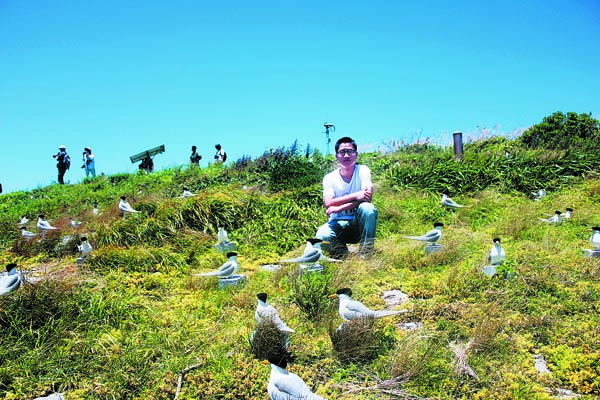

"The taller bushes were cut away, while 400 fake birds of the same size as Chinese crested terns were placed, with a bird sound playback system configured to simulate the sound of courtship," Ding says.
After two months of laying the groundwork, Ding and a volunteer from the United States set up an observation point on Jigushan Island, right across from Zhongtiedun, at a large enough distance so as not to disturb their mating activity.
However, they were unable to attract any of the birds over the following two months.
"The experts believed the breeding period had passed and suggested withdrawing the equipment and making plans for the next year," Ding recalls.
However, right after they decided to give up for the year, there was a twist of events.
"I saw a big group of great crested terns hovering in the sky when I was packing my stuff," Ding says.
It gave him hope, because Chinese crested terns have often been observed living among their close relatives the great crested terns. It is not easy to spot the differences between the two, but the former's mouth is one-third black, and it is slightly smaller.
Ding proposed that the equipment that had been installed on the island not be taken down. Two days later, the team got what they wished for — several Chinese crested terns were found among the group of great crested terns hovering in the sky.
"I felt all the waiting was worth it," he says.
The experts canceled their trips back home and remained on the island. They found about 19 Chinese crested terns that year, including two fledglings.
"It's amazing that we were successful the first year," Ding says, adding that even the most sophisticated breeding projects often take three to five years to successfully draw in bird species with larger populations than the Chinese crested tern.
From then on, Chinese crested terns settled on Zhongtiedun, and as if by word of mouth, more came.
Ornithologists also migrated to the island. In 2014, Ding and his colleagues set up a tent in the remote locale as their residence and work station. Ding would take a camera and computer to shoot and record the terns, and protect them from being hurt by intruders and other animals, working with professional snake hunters and keeping fishermen away.
Ding and his colleagues have kept track of the exact numbers during their observations over the following years. The number of adult birds has gone from 41 in 2014 to 93 this year, and the number of fledglings from 13 to 36.
"Since the launch of the restoration project, Zhongtiedun has become the world's largest breeding site for Chinese crested terns," Ding says.
At least 150 fledglings have been hatched, accounting for more than 80 percent of total new births around the world.
"Ding and other nature protectors, including international partners and many volunteers, have done a lot to protect the species," says Fan Zhongyong, a senior researcher from the Zhejiang Museum of Natural History.
The museum has cooperated with the nature reserve Ding's been working at and offered technical support for the project since 2004.
"From the look of things now, we've eliminated the risk of extinction for Chinese crested terns," Fan says.
All participating parties will continue working together to raise the breeding quality of Chinese crested terns and increase their numbers.
"We'll also develop more breeding habitats for them in Zhejiang, and apply methods that have proved successful with the protection of Chinese crested terns to that of other seabirds," Fan adds.
Looking back at his life on the islet, Ding admits that it was very tough. Electricity had to be acquired from a solar panel that barely provided enough to charge mobile phones, and there was no air conditioner in the sizzling summer. Drinking water was sent in by supply ships. The worst was the loneliness, though things took a turn for the better in 2017, when more volunteers came to join the bird protection team.
"Everything was worth it, now that more people are aware of the importance of protecting the birds, and now that their numbers are on the rise," Ding says.
Ding's contributions were recognized by the local authorities of Ningbo this year, who named him one of the city's "most beautiful people". He hopes his team's conservation efforts will be replicated in other domains.
"I believe more species in the area will benefit from the work we have done for the Chinese crested terns," he says.